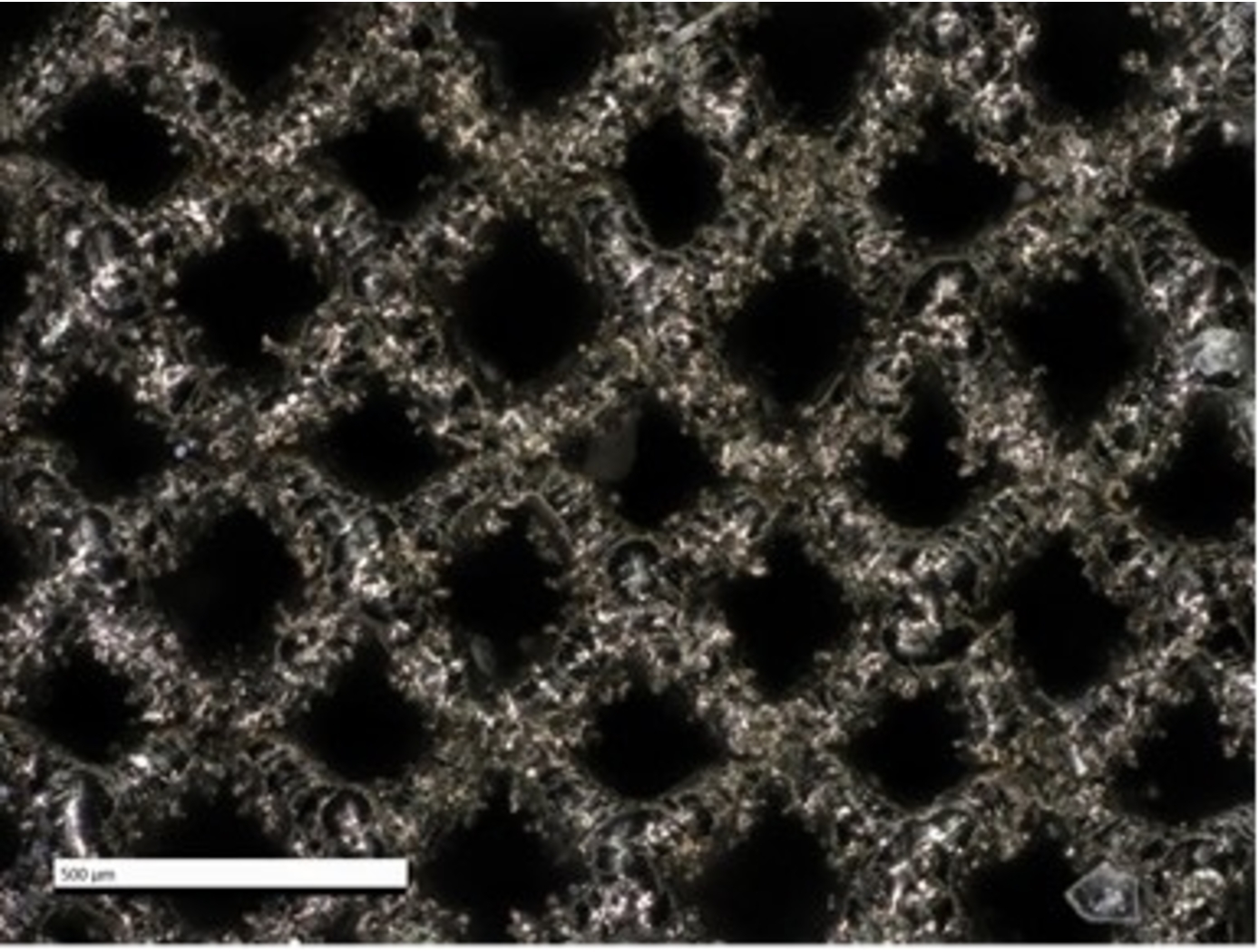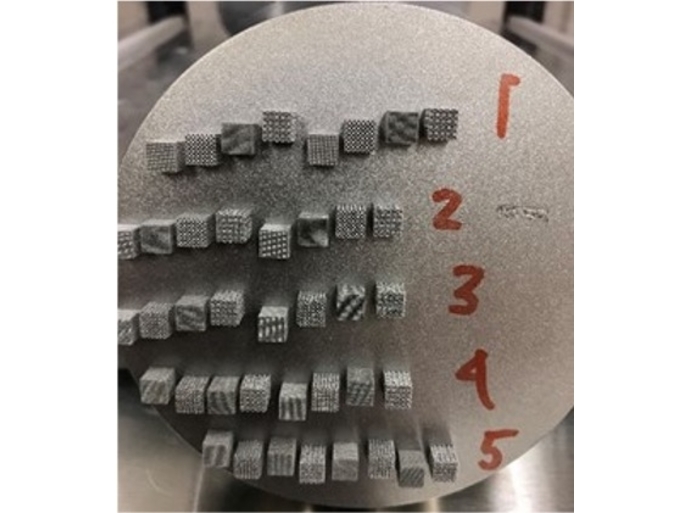Additively Manufactured Propulsion Catalysts
Manufacturing
Additively Manufactured Propulsion Catalysts (MFS-TOPS-120)
Ultra-Fine Lattice Structures
Overview
In mono-propulsion systems, a propellant is flowed across a catalyst to promote a chemical reaction and generate thrust. Conventional catalyst manufacturing methods entail (a) coating the inner walls of the thruster nozzle with a catalyst (generally undesirable due to limited catalyst-propellant contact), or (b) inserting a metal or graphite foam coated with a catalyst material into the thruster chamber. Method (b), while superior in terms of thrust generation, also possesses several limitations. Metal/graphite foams are difficult and expensive to procure, stochastic/random in nature (e.g., possess high variability in terms of geometric and other properties), and must be jammed into the thruster chamber using a compression plunger during installation – a process that often leads to catalyst damage.
A new manufacturing method that improves repeatability, thruster reactivity, and tailorability (e.g., mechanical, chemical, and fluid flow) while reducing cost and lead time is thus highly desirable. To address this need, NASA and EOS developed methods to additively manufacture (AM) ultra-fine lattice structure propulsion catalysts.
The Technology
Working with EOS, a market leader in additive manufacturing (AM) technology, NASA has pioneered the use of AM to achieve improved performance and cost reduction of propulsion catalyst systems. As mentioned above, conventional mono-propulsion catalysts are comprised of ceramic or graphite foams, which possess thousands of irregular pores with non-uniform size and distribution. Due to the lack of granular control in the manufacturing process, such foams are limited in terms of feasible designs. These foams also exhibit anisotropic mechanical properties and inconsistent fluid flow behavior. Furthermore, such catalysts are produced by a limited number of vendors, constraining availability and inflating cost. As with several other aerospace structures, AM of mono-propulsion catalysts enables increased manufacturing capabilities (e.g., granular geometric control, repeatability) while reducing cost and lead time.
NASA and EOS leveraged AM to generate ultra-fine lattice structures – repeating unit cells with ligament thickness as small as 100 microns – to replace coated ceramic or graphite foam catalysts. These AM lattice structures offer several advantages including increased control of structure topology, unconstrained designed flexibility, improved compressive strength, and fluid flow optimization – all printed into a single component from a preferred refractory platinum metal. Granular control of structure topology allows for tailored percent relative density (%RD), which in turn allows manufacturers to control the mechanical and fluid flow properties of the final catalyst structure. In other words, NASA’s AM ultra-fine lattice catalyst structures significantly improve upon the drawbacks of conventional catalysts by offering a higher degree of control over the structure, enabling the generation of catalysts with customized material properties. In addition, the use of AM ensures the catalysts exhibit high spatial symmetry and can be generated in a repeatable (non-stochastic) manner, all while reducing cost and lead times.
While NASA and EOS' ultra-fine lattice structures were originally developed for mono-propellant systems (e.g., green propellant thruster catalysts), the same structures and manufacturing technologies can be applied to liquid or gas permeable rigid materials, evaporative film cooling heat exchangers, filtering, and other applications.


Benefits
- Improved catalyst performance: The ultra-fine lattice structures have been demonstrated to improve compressive strength and flow optimization relative to coated foams.
- Design flexibility: In contrast to coated foams, NASA and EOS' lattice structures offer unconstrained design flexibility - greater control over structure topology allows for customized percent relative density (%RD), which can be manipulated to control mechanical and fluid flow properties.
- Reduced cost & manufacturing schedule: In addition to improved performance, ultra-fine lattice propulsion catalysts can be manufactured at significantly reduced cost, and much faster, relative to coated foam catalysts. Production costs (e.g., feedstock, labor time, post-processing) are very low, with improved schedule control.
- Proven: Testing data demonstrates that ultra-fine lattices meet all the requirements of mono-propellant catalysts and possess mechanical and flow properties as good as, or better than, conventional coated foams.
Applications
- Mono-propellant thruster catalysts: This invention was originally developed to provide thruster catalysts with improved properties for mono-propellant systems (e.g., green propellant thruster catalysts).
- Liquid or gas permeable rigid materials
- Evaporative film cooling heat exchangers
Technology Details
Manufacturing
MFS-TOPS-120
MFS-33964-1
"Development of Additive Manufactured Ultra-Fine Lattice Structures Propulsion Catalyst," Mireles, Omar, et. al., August 17, 2020, https://arc.aiaa.org/doi/abs/10.2514/6.2020-3502
|
Tags:
|
|
|
Related Links:
|
Similar Results

Holey Carbon Allotropes
This invention is for scalable methods that allows preparation of bulk quantities of holey nanocarbons with holes ranging from a few to over 100 nm in diameter. The first method uses metal particles as a catalyst (silver, copper, e.g.) and offers a wider range of hole diameter. The second method is free of catalysts altogether and offers more rapid processing in a single step with minimal product work-up requirements and does not require solvents, catalysts, flammable gases, additional chemical agents, or electrolysis. The process requires only commercially available materials and standard laboratory equipment; and, it is scalable. Properties that can be controlled include: surface area, pore volume, mechanical properties, electrical conductivity, and thermal conductivity.

Aerofoam
The Aerofoam composites have superior thermal and acoustic insulation properties when compared to conventional polyimide foams. In addition, they provide greater structural integrity than the fragile aerogel materials can provide independently. In general, polymer foams can provide excellent thermal insulation, and polyimide foams have the additional advantage of excellent high-temperature behavior and flame resistance compared to other polymer systems (they do not burn or release noxious chemicals). Incorporating aerogel material into the polyimide foam as described by this technology creates a composite that has been demonstrated to provide additional performance gains, including 25% lower thermal conductivity with no compromise of the structural integrity and high-temperature behavior of the base polyimide foam. The structural properties of Aerofoam are variable based on its
formulation, and it can be used in numerous rigid and flexible foams of varying densities.
Aerofoam has a number of potential commercial applications, including construction, consumer appliances, transportation, electronics, healthcare, and industrial equipment. In addition, these high-performance materials may prove useful in applications that require insulation that can withstand harsh environments, including process piping, tanks for transporting and storing hot or cold fluids, ship and boat building, and aerospace applications.

In-Situ Resource Utilization (ISRU): Methylotrophic Microorganisms Expressing Soluble Methane Monooxygenase Proteins
Microorganisms are unique from the standpoint that they can be employed as self-replicating bio-factories to produce both native and engineered mission relevant bio-products. Methane (CH4) usage in In-Space Manufacturing (ISM) platforms has been discussed previously for human exploration and has been proposed to be used in physicochemical systems as a propulsion fuel, supply gas, and in fuel cells. Carbon Dioxide (CO2) is abundant on Mars and manned spacecraft. On the International Space Station (ISS), NASA reacts excess CO2 with Hydrogen (H2) to generate CH4 and Water (H2O) using the Sabatier System (Figure 1). The resulting water is recovered in the ISS, but the methane is vented to space. Recapturing this methane and using it for microbial manufacturing could provide a unique approach in development of in-space bio-manufacturing. Thus, there is a capability need for systems that convert methane into valuable materials. Methane (CH4) is a potential carbon substrate for methanotrophic microorganisms which are able to metabolize CH4 into biomass. The innovative technology from NASA Ames Research Center ports Soluble Methane Monooxygenase (sMMO) to Pichia, that is, it moves the methane metabolism into a robust microbial factory (Pichia pastoris) (Figure 2). The yeast Pichia pastoris is a refined microbial factory that is used widely by industry because it efficiently secretes products. Pichia could produce a variety of useful products in space. Pichia does not consume methane but robustly consumes methanol, which is one enzymatic step removed from methane. This novel innovation engineers Pichia to consume methane thereby creating a powerful methane-consuming microbial factory and utilizing methane in a robust and flexible synthetic biology platform.

A One-piece Liquid Rocket Thrust Chamber Assembly
The one-piece multi-metallic composite overwrap thrust chamber assembly is centrally composed of an additively manufactured integral-channeled copper combustion chamber. The central chamber is being manufactured using a GRCop42 or GRCop84 copper-alloy additive manufacturing technology previously developed by NASA. A bimetallic joint (interface) is then built onto the nozzle end of the chamber using bimetallic additive manufacturing techniques. The result is a strong bond between the chamber and the interface with proper diffusion at the nozzle end of the copper-alloy. The bimetallic interface serves as the foundation of a freeform regen nozzle. A blown powder-based directed energy deposition process (DED) is used to build the regen nozzle with integral channels for coolant flow. The coolant circuits are closed with an integral manifold added using a radial cladding operation. To complete the TCA, the entire assembly including the combustion chamber and regen nozzle is wrapped with a composite overwrap capable of sustaining the required pressure and temperature loads.

Molecular Adsorber Coating (MAC)
MAC is a zeolite based coating that captures and traps molecules in its microscopically porous structure. This microscopic nano-textured structure, consisting of large open pores or cavities, within a crystal- like structure, provides a large surface area to mass ratio that maximizes available trapping efficiency. MAC is a durable coating that is applied through spray application.
These sprayable coatings eliminate the major drawbacks of puck type adsorbers (weight, size, and mounting hardware requirements), resulting in cost savings, mass savings, easier utilization, greater adsorber surface area, more flexibility, and higher efficiency.
This coating works in air, as well as vacuum systems, depending on the application. There is potential for ground based spin-off applications of this coating, particularly in areas where contaminants and volatile compounds need to be collected and contained. Example industries include: pharmaceutical production, the food industry, electronics manufacturing (circuit boards and wafers), laser manufacturing, vacuum systems, chemical processing, paint booths, and general gas and water adsorption.



